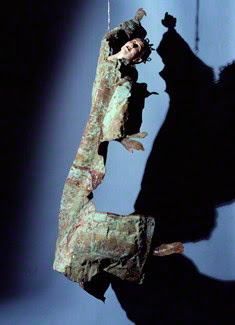 |
| Islay Standing, ©Nadav Kander, courtesy Flowers Gallery, London |
BODIES - 6 Women, 1Man
Flowers Gallery London
Flowers Gallery London
until February 8th
'Wherever I may be, my pictures seek to expose the shadow and the vulnerability that exists in all of us, and it is this vulnerability that I find so beautiful'.
Coated in white marble dust and set against the stark background of the photographer's studio, the subjects of this set of dramatic chromogenic prints tease us with references to Classical and Renaissance art. Some also resonate with what we know of religious iconography and tomb sculpture. But that is not the focus of this exhibition.In Islay Standing she turns her face away from the viewer, with her hair tumbling and twisting like that of Botticelli's Venus. She stands revealed, yet concealed, with outspread fingers shielding her eyes from some unseen danger - or from the viewer? Below, in Audrey with Toes and Wrist Bent we see a woman reclining with toes and fingers curled and compressed in an uncomfortable and unsustainable stance.The use of the sitters' names remind us that these are real people, individuals in the here and now, and not mythological figures.
Drawing on the conventions of earlier art works, Kander is inviting us to engage in a visual dialogue between the past and the present, between notions of 'perfection' and the beauty of a living, breathing human being. He exposes the shadow and vulnerability that exists in everyone, unique and idiosyncratic as we are. The result is tender, wise and compassionate. For once we escape the scarifying pressure of artificial airbrushed perfection and that of sickly sentimentality.He describes his work as 'an enquiry into what it feels like to be human' and invites us to meditate on the beauty which lies in our all-too-human vulnerability.
Zoe Pilger's review The Naked Truth in the Independent on 14.1.13, referenced below, alludes to other work by Kander, including his prize-winning Yangtze, The Long River.
 |
| Audrey with Toes and Wrist Bent, ©Nadav Kander, courtesy Flowers Gallery, London |
nadavkander.com/
http://www.independent.co.uk/arts-entertainment/art/reviews/the-naked-truth-nadav-kander-bodies-6-women-1-man
flowersgallery.com
markquinn.com
BODIES 6 Women, 1 Man by Nadav Kander, published by Hatje Cantz





